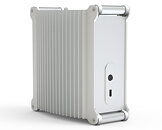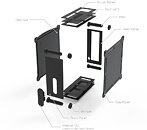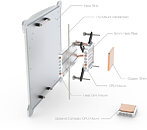- Joined
- Oct 9, 2007
- Messages
- 47,631 (7.44/day)
- Location
- Dublin, Ireland
| System Name | RBMK-1000 |
|---|---|
| Processor | AMD Ryzen 7 5700G |
| Motherboard | Gigabyte B550 AORUS Elite V2 |
| Cooling | DeepCool Gammax L240 V2 |
| Memory | 2x 16GB DDR4-3200 |
| Video Card(s) | Galax RTX 4070 Ti EX |
| Storage | Samsung 990 1TB |
| Display(s) | BenQ 1440p 60 Hz 27-inch |
| Case | Corsair Carbide 100R |
| Audio Device(s) | ASUS SupremeFX S1220A |
| Power Supply | Cooler Master MWE Gold 650W |
| Mouse | ASUS ROG Strix Impact |
| Keyboard | Gamdias Hermes E2 |
| Software | Windows 11 Pro |
The high-end CPU and GPU performance arms race has been pushing power and TDP limits higher but fortunately, progress is also being made for more power-efficient CPUs with much lower TDPs that still offer competitive performance thanks to improvements in their integrated graphics. Whilst there is no shortage of fanless cases on the market that can cool these lower TDP CPUs, they have been geared towards industrial applications, tend to be expensive, and offer very little in the way of design.
The DB1 is here to change that with a case that delivers all the benefits of fanless/silent computing, but in an ultra-compact form factor that once again breaks the mould of typical fanless cases. With a total volume less than 5 l (222 x 222 x 101 mm), the DB1 is our most compact fanless case but can still comfortably handle 45 W of cooling, which is ideal for power-efficient systems based on the new generation of APU/iGPUs that deliver excellent performance/watt.





The DB1 is constructed from 4 mm thick aluminium panels, a 21 mm thick extruded heat sink, solid aluminium pillars and is made using CNC milling and finished with sandblasted/anodized surface treatment, but despite using these premium materials, processing and finish, is extremely competitively priced.
The beauty of the DB1 (apart from its appearance) is the simplicity of its design that used 4 solid aluminium pillars to connect the heat sink and side panel that in turn secure the front, rear, upper and lower panels in place. This approach greatly reduces complexity, combines functionality (as the pillars also serve as the feet), and mean that the entire case can be fully disassembled with just 8 screws.
This design also allows for great flexibility in orientation and placement of the case, every panel can be rotated to allow for left or right positioning and inverted orientations. The modularity also means that requirements for customization are lower, making this an excellent platform for system integrators.
With our approach to fanless, the cooling is done by the case itself and the DB1 is no exception. Using the same copper CPU shim, adjustable CPU mount and heat sink mount as our DB4, heat is transferred from the CPU to the heat sink (side panel) using 6mm copper heat pipes and dissipated into the environment along its surface and fins which are optimised for natural convection.
With the combination of the universal CPU mount and fully position adjustable heat sink mount, there are virtually no motherboard compatibility issues as the socket location is not a limiting factor and conflicts with board components are minimised.
The stock CPU mount is compatible with all current desktop sockets and there is also an optional compact CPU mount to expand that compatibility to less common sockets such as FCBGA 1667 or even more specialist soldered CPUs.
It's hard to appreciate just how small and tightly packed some our compact cases are, to the extent that we sometimes get asked if it's possible to install an SFX or even ATX PSU inside them.
For some context, the DB1 is not much larger than the ITX motherboard it holds, and this ultra small form factor is only made possible by the use of a NanoPSU that plugs directly into the motherboard.
Apart from reducing the space required, use of the Nano PSU has two other advantages,
With the target TDP, power draw and price point that the DB1 was designed for, it was important to have a suitable matching power solution, so we are introducing a new NanoPSU that can match these criteria. The Nano90 is our most compact and affordable NanoPSU yet, delivering 90 W of power with zero noise and will be available at the launch of the DB1.
Modularity and versatility are principles we always try to incorporate into our designs, so with the DB1 we have made all the panels interchangeable and added an option to rotate the internals by 90 degrees, allowing any variation of heat sink and front panel position/orientation.
The DB1 was of course design to work primarily in the vertical orientation as that occupies the least amount of desk space and also gives the best cooling performance as convection is optimised. It can however also be used in the horizontal orientation with the ability to position the front I/O at either side of the case. The front I/O is also modular and uses the same module as the DA2 so included Type-A 19PIN can be replaced with an optional Type-C 19PIN or 3.1 Gen2 or any future standard. This modularity and cross-platform approach is part of our wider commitment to product continuity and ensuring the case you buy today does not become obsolete when new hardware is released.
View at TechPowerUp Main Site
The DB1 is here to change that with a case that delivers all the benefits of fanless/silent computing, but in an ultra-compact form factor that once again breaks the mould of typical fanless cases. With a total volume less than 5 l (222 x 222 x 101 mm), the DB1 is our most compact fanless case but can still comfortably handle 45 W of cooling, which is ideal for power-efficient systems based on the new generation of APU/iGPUs that deliver excellent performance/watt.





The DB1 is constructed from 4 mm thick aluminium panels, a 21 mm thick extruded heat sink, solid aluminium pillars and is made using CNC milling and finished with sandblasted/anodized surface treatment, but despite using these premium materials, processing and finish, is extremely competitively priced.
The beauty of the DB1 (apart from its appearance) is the simplicity of its design that used 4 solid aluminium pillars to connect the heat sink and side panel that in turn secure the front, rear, upper and lower panels in place. This approach greatly reduces complexity, combines functionality (as the pillars also serve as the feet), and mean that the entire case can be fully disassembled with just 8 screws.
This design also allows for great flexibility in orientation and placement of the case, every panel can be rotated to allow for left or right positioning and inverted orientations. The modularity also means that requirements for customization are lower, making this an excellent platform for system integrators.
With our approach to fanless, the cooling is done by the case itself and the DB1 is no exception. Using the same copper CPU shim, adjustable CPU mount and heat sink mount as our DB4, heat is transferred from the CPU to the heat sink (side panel) using 6mm copper heat pipes and dissipated into the environment along its surface and fins which are optimised for natural convection.
With the combination of the universal CPU mount and fully position adjustable heat sink mount, there are virtually no motherboard compatibility issues as the socket location is not a limiting factor and conflicts with board components are minimised.
The stock CPU mount is compatible with all current desktop sockets and there is also an optional compact CPU mount to expand that compatibility to less common sockets such as FCBGA 1667 or even more specialist soldered CPUs.
It's hard to appreciate just how small and tightly packed some our compact cases are, to the extent that we sometimes get asked if it's possible to install an SFX or even ATX PSU inside them.
For some context, the DB1 is not much larger than the ITX motherboard it holds, and this ultra small form factor is only made possible by the use of a NanoPSU that plugs directly into the motherboard.
Apart from reducing the space required, use of the Nano PSU has two other advantages,
- It reduces the amount of heat being dumped inside the case as the AC to DC conversion is happening in the external AC adapter, and
- It is fanless, no need to expand on how important that is for a fanless system
With the target TDP, power draw and price point that the DB1 was designed for, it was important to have a suitable matching power solution, so we are introducing a new NanoPSU that can match these criteria. The Nano90 is our most compact and affordable NanoPSU yet, delivering 90 W of power with zero noise and will be available at the launch of the DB1.
Modularity and versatility are principles we always try to incorporate into our designs, so with the DB1 we have made all the panels interchangeable and added an option to rotate the internals by 90 degrees, allowing any variation of heat sink and front panel position/orientation.
The DB1 was of course design to work primarily in the vertical orientation as that occupies the least amount of desk space and also gives the best cooling performance as convection is optimised. It can however also be used in the horizontal orientation with the ability to position the front I/O at either side of the case. The front I/O is also modular and uses the same module as the DA2 so included Type-A 19PIN can be replaced with an optional Type-C 19PIN or 3.1 Gen2 or any future standard. This modularity and cross-platform approach is part of our wider commitment to product continuity and ensuring the case you buy today does not become obsolete when new hardware is released.
- The DB1 will be available with resellers in Q1 2021 to retail for ~ 109EUR / 129USD.
- The Nano90 will be available at the same time with a retail price of ~ 68EUR / 79USD.
View at TechPowerUp Main Site





